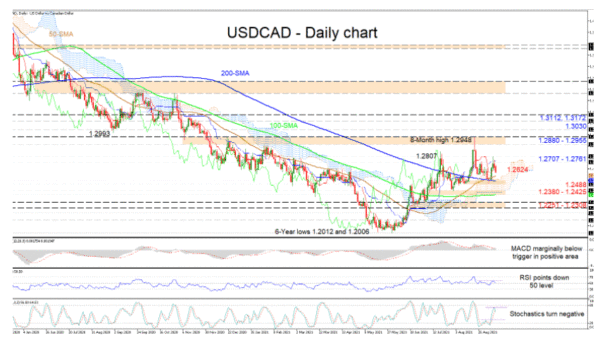USDCAD, currently at the red Tenkan-sen line at 1.2624, is surrendering ground from the 1.2761 high after its recently made headways, resulting from a bounce off the 200-day simple moving average (SMA). The longer-term 100- and 200-day SMAs are validating a more neutral tone in the pair. That said, the bullish crossover of the 200-day SMA by the 50-day SMA has yet to confirm that sellers are now taking the lead.
The somewhat static Ichimoku lines are indicating a pause in downward forces since the price retreated from the 1.2948 high, while the short-term oscillators are negatively skewed. The MACD, in the positive zone, is being capped by its red trigger line, while the downward facing RSI is flirting with the 50 threshold. The negative charge in the stochastic oscillator is promoting additional bearish price action.
If sellers stay in the driver’s seat, initial downside friction could arise at the 50-day SMA at 1.2573 ahead of the support belt of 1.2488-1.2521. Diving beneath the 200-day SMA, the pair may target the support barricade of 1.2380-1.2425, which encompasses the Ichimoku cloud’s floor as well. From here, a deeper decline could then encounter its next obstruction around the 1.2251-1.2308 barrier.
If buying interest increases, the first region to try and mute upside forces may reside between 1.2707 and 1.2761. However, conquering it could catapult the price to challenge the tough resistance section of 1.2880-1.2955. Passing this reinforced boundary, the pair may then meet the 1.3030 barrier, while another push higher could face the 1.3112 and 1.3172 highs from mid-November 2020.
Summarizing, USDCAD seems to lack convincing upside power and is somewhat adopting a sideways pattern. A clearer price direction could evolve either with a break above 1.2761 or below 1.2488.















